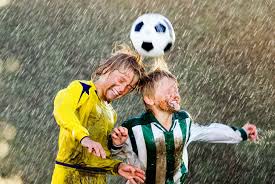By Ben Nicholson
November 12 – In response to a pending lawsuit regarding concussion protection amongst youth ‘soccer’ players, the United States Soccer Federation (USSF) has changed its practices so as to improve concussion awareness and education, and ban heading altogether for U10s.
The lawsuit that propelled the change originated in California, amongst players and parents concerned with the monitoring and protection of concussions, and was pending in federal court. The plaintiffs were requesting a rule change rather than monetary damages.
But 15 months later the suit was settled without the need for judicially enforced remedy. USSF stated: “The United States Soccer Federation and the other youth member defendants, with input from counsel for the plaintiffs, have developed a sweeping youth soccer initiative designed to (a) improve concussion awareness and education among youth coaches, referees, parents and players; (b) implement more uniform concussion management and return-to-play protocols for youth players suspected of having suffered a concussion; (c) modify the substitution rules to insure such rules do not serve as an impediment to the evaluation of players who may have suffered a concussion during games; and (d) eliminate heading for children 10 and under and limit heading in practice for children between the ages of 11 and 13.”
Although monetary damages were neither sought nor awarded, the USSF, as part of the settlement agreement, are to pay the plaintiffs’ $590,000 attorney fees.
The ban on heading is in force for all U.S. national teams and Major League Soccer academies, but is only recommended practice for the clubs and associations outside of USSF control.
More details of the sweeping initiative are promised to manifest within the next 30 days.
Steve Berman, the plaintiffs’ lead counsel was happy to achieve his clients’ objective “to focus the attention of U.S. Soccer and its youth member organisations on the issue of concussions in youth soccer.
“With the development of the youth concussion initiative by U.S. Soccer and its youth members,” he continued, “we feel we have accomplished our primary goal and, therefore, do not see any need to continue the pursuit of the litigation. We are pleased that we were able to play a role in improving the safety of the sport for soccer-playing children in this country.”
The plaintiff’s initial court filing alleged that in 2010 over 50,000 high school soccer players sustained concussions, which was more than were sustained in softball, basketball, baseball and wrestling combined.
On the plus side, this may suggest that quite a lot of people are choosing to play soccer in high school. On the negative side, from a statistical standpoint, the heading ban does not affect heading for high school aged players (nor would necessarily be imposed on schools since they are not under the thumb of USSF).
However, though the heading ban is generating the sensationalist headlines, the real work is being done on the educational front. Additionally, the real danger is less in the heading of the ball but rather the player-on-player collisions that result in concussions.
A JAMA Pediatrics study documents that from 2005 to 2014, 17% of concussions in boys soccer and 29% of concussions in girls soccer resulted from direct contact with a soccer ball. 70% of boys’ concussions and 51% of girls’ concussions were due to player collisions.
Many of the player collisions, however, were caused by attempts to head the ball. Therefore heading was the proximate cause for 30.6% of boys’ concussions and 25.3% of girls’ concussions.
The study concluded: “Although heading is the most common activity associated with concussions, the most frequent mechanism was athlete-athlete contact. Such information is needed to drive evidence-based, targeted prevention efforts to effectively reduce soccer-related concussions. Although banning heading from youth soccer would likely prevent some concussions, reducing athlete-athlete contact across all phases of play would likely be a more effective way to prevent concussions as well as other injuries.”
Since athlete-athlete contact is difficult to reduce in soccer without reducing soccer altogether, the settlement agreement appears to have protected the most important aspects of the sport.
The report suggested that stricter enforcement of the current rules would reduce the instances of concussion-inducing athlete-to-athlete contact. However, much to the dismay of youth soccer enthusiasts across the US, no provision in the settlement spoke to improving referee standards that could address the enforcement failures.
U.S. Soccer CEO/Secretary General Dan Flynn of the United States Soccer Federation representing the Federation and the other youth members said: “We are proud to be leaders in the areas of concussion education and management. The development of a player safety initiative was under way before the current lawsuit was filed. In constructing the concussion component, U.S. Soccer sought input from its medical science committee which includes experts in the field of concussion diagnosis and management, as well as from its technical advisors, and worked with its youth members to develop a true consensus-based program. We are pleased that the plaintiffs and their counsel recognise the steps we have taken and look forward to sharing the benefits of the youth concussion initiative with players, coaches, officials and parents.”
A similar suit named FIFA as a defendant but it was dismissed for lack of standing. And another similar suit, filed by the same law firm, is being brought against the NCAA.
Contact the writer of this story at moc.l1751838344labto1751838344ofdlr1751838344owedi1751838344sni@n1751838344osloh1751838344cin.n1751838344eb1751838344

